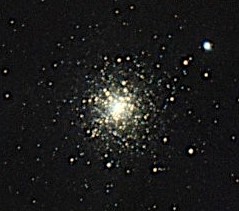As usual, students were asked to select a deep sky object as one of their imaging projects.
The term 'Deep Sky Object' (DSO) is generally used to refer to any astronomical object that is not an individual star or a Solar System object. As such, millions of DSOs are known, the vast majority of which are star clusters, nebulae, and galaxies. Almost all DSOs are so dim that they are invisible to the naked eye and so long-exposure 'astrophotography' is needed to expose them to human view. Even for the few brighter DSOs (e.g. the Pleiades star cluster, Andromeda Galaxy, and a few more) astrophotography can reveal much more detail and color than can be seen visually.
Imaging of particular DSOs is usually accomplished by replacing the eyepiece on a telescope with a sensitive camera that records many images, each taken for a period from several seconds to many minutes. To ensure the Earth's rotation does not produce 'star trails' the equipment must ride on a mount that counteracts these effects. In addition, a separate 'guide' camera and telescope is often used to make adjustments to the mount every few seconds. Such an imaging session can last many hours, and even spread over several nights. In the processing phase, the individual images are corrected for thermal and electronic noise generated within the imaging camera itself, and also for the non-uniform response of the whole optical system across the image plane. These calibrated frames are then 'stacked' together to reduce the 'signal to noise' ratio. This stacked image is then 'stretched' to reveal the details hidden in it and then fine adjustments are made 'to taste'.
Click on the thumbnails below to see each student's final image and their own description of what it shows and how it was produced.

Emily's project was to image the Jellyfish Cluster (Messier 30), a globular cluster of stars in southern constellation of Capricornus.

Austin chose to image the Iris Nebula, a bright reflection nebula in the circumpolar constellation Cepheus.

Emma imaged Messier 2, one of largest known globular clusters. It lies in the equatorial constellation of Aquarius.
© Copyright © 2024.Tennessee Tech all rights reserved